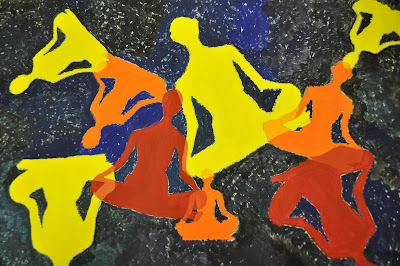
Deanne Fitzmaurice/ Saleh
In this photograph, by Deanne Fitzmaurice taken in 2004, Saleh seems to be very invested in his drawing. Wearing his shades and taping a pencil to his arm, Saleh is still not fully recovered from the surgery nor the bombing, but he starts drawing again. On October10, 2003, while Saleh Khalaf was walking back from school, in Baghdad, he picked up something that looked like a toy ball, but after a few seconds, this toy ball exploded in his hands, ripping his abdomen, tearing off his right hand and most of his fingers on the left, and blown out one of his eyes(Fitzmaurice). Luckily enough, Saleh and his dad, Raheem, came to Children’s Hospital in Oakland, CA, for his treatment (Fitzmaurice).
Fitzmaurice took this photograph during Saleh’s recovery. Saleh was stressed and angered by the countless stares and glances he received from strangers as he was staying in the hospital. In order to soothe his anger, the nurses taped a pencil around his arm so he could start drawing again (Fitzmaurice). Instead of drawing a happy family or a positive image, Saleh drew an airplane dropping a bomb. A bomb that he picked up entirely changed his life. However, Saleh does not seem to be depressed in this photograph. Instead, he seems to be concentrated on what he is doing. He probably practiced how to use his arm for drawing instead of his fingers. While he is sketching, he doesn’t need to receive the sympathetic glances from anyone else. It is very ironic to see his hopeful expression and the depressing subject of his painting. According to Wikileak’s log about Iraq war, 92,003 Iraqi civilian died between January 2004 to 2009 (Wikipedia). This vast number of civilian death shows how many innocent lives were sacrificed in a purposeless war. The goal of this war to find the Weapons of Mass Destruction(WMD), that was actually never discovered.
Fitzmaurice won the Pulitzer Prize in 2004 for feature photography with a series of Saleh’s photos. This photo especially depicts how a war can destroy one’s life. A bomb that a U.S. soldier dropped entirely changed one ordinary boy’s life. As he grows older, Saleh will need to fight the physical difficulties and the social prejudices he faces in everyday life. This photograph raises awareness about war and destruction for the general public of U.S, who often forget about the horror of war because their nation hasn’t become the battleground. Just because there aren’t any bombs dropping in our own backyard, people often forget the numerous lives sacrificed during the war. However, there are many victims just like Saleh or even worse, who lost their lives or their bodies because of the war.
This piece delivers a message of hope in times of despair. Even though Saleh will need to fight various obstacles through his life, it is miraculous that he is alive. If there wasn’t the effort of the American hospitals and his father’s eagerness to save his son, Saleh might not be able to even draw with his arm. Saleh’s concentrated eyes and his determination to draw with his arm imply that Saleh won’t give up on the journey of his life. As he walks through his journey of life, we can still hope for a better future.






